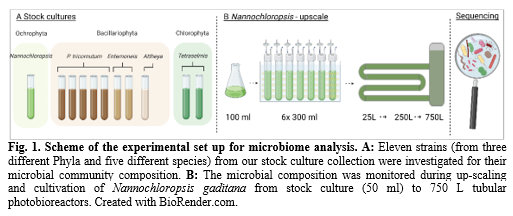A CLOSER LOOK INTO THE MICROBIOME IN MICROALGAE CULTURES
Introduction
Although bacteria are commonly co-occurring in microalgae cultivation and production systems, there is little knowledge about their impact on microalgae production. Certain bacteria have been described to stimulate or promote microalgae growth [1–3], while others can compete with the microalgae for resources or produce toxic substances, and therefore decrease the production yields [4]. Moreover, specific bacteria have also been associated with culture crashes [5], and knowledge of bacterial composition is also important in the context of product quality when the algae biomass is to be used for future food and feed. Thus, a better understanding of the bacteria that co-occur in microalgae cultures is important to optimize microalgae production and to ensure product quality. The aim of this study was to investigate if and how the bacterial community composition is related to specific microalgae species or strains, growth conditions and growth systems.
Methods
To investigate if different microalgae cultures have specific bacterial communities, the microbiome of 11 stock cultures, covering various species and strains from different phyla were analyzed (Fig. 1A). All strains have been maintained at the same growth conditions over several years. Furthermore, to investigate if the bacterial community changes across the growth system scales, the bacterial community composition was analyzed during an upscaling process of Nannochloropsis gaditana from stock culture (50 mL) via cultivation tubes (300 mL) to tubular 25 L, 250 L and 750 L photobioreactors (Fig. 1B). The bacterial diversity was assessed by DNA extraction, amplification of the V5-V7 region of the 16S rRNA gene using the chloroplast-excluding primers 799F (5′-AACMGGATTAGATACCCKG-3′) and 1193R (5′-ACGTCATCCCCACCTTCC-3′), followed by Illumina sequencing.
Results
The dominant bacteria genera present in the different microalgae cultures belonged to the classes Alphaproteobacteria, Gammaproteobacteria (Phylum Proteobacteria) and Bacteroidia (Phylum Bacteroidota). The microbial diversity in microalgae stock cultures varied strongly between the different microalgae species but was similar for different strains of the same species. The five P. tricornutum strains were dominated by the genera Oceanicaulis and Yoonia-Loktanella (Alphaproteobacteria), while two of the five strains also had increased abundance of the genus Owenweeksia (Bacteroidia). The two Entemoneis strains were dominated by Maribacter (Bacteroidia) and different Alphaproteobacteria genera, while the two Tetraselmis species mainly contained the genus Marinobacter (Gammaproteobacteria). For Nannochloropsis, bacteria could not be detected for the stock cultures and 300 ml culture samples. Only during the up-scaling process at the stage of tubular photobioreactor systems, bacteria were present in detectable quantities. Although the bacterial communities varied slightly during the cultivation processes and reactor systems, cultures were always dominated by the genus Flavobacterium or Ulvibacter (Bacteroidia) or the combination of both.
Discussion
Our results reveal that different microalgae species, although kept at the same cultivation conditions over several years, display separate and unique microbial communities. However, different strains of the same species (P. tricornutum, Entemoneis) or genus (T. suecica, T. chui) had very similar bacterial community compositions, although originating from different habitats. This indicates that different microalgae species can modulate their microbial communities and might favor for specific bacterial co-habitants. Furthermore, our results show, that the microbial community remained relatively stable during large scale cultivation of Nannochloropsis also over different reactor scales. Strong changes were only observed between the dominance of two different genera, which could be related to specific cultivation conditions.
References
[1] J. Liu, A.J. Lewitus, P. Brown, S.B. Wilde, Growth-promoting effects of a bacterium on raphidophytes and other phytoplankton, Harmful Algae. 7 (2008) 1–10. https://doi.org/10.1016/j.hal.2007.04.009.
[2] Y. Park, K.W. Je, K. Lee, S.E. Jung, T.J. Choi, Growth promotion of Chlorella ellipsoidea by co-inoculation with Brevundimonas sp. isolated from the microalga, Hydrobiologia. 598 (2008) 219–228. https://doi.org/10.1007/s10750-007-9152-8.
[3] S. Yao, S. Lyu, Y. An, J. Lu, C. Gjermansen, A. Schramm, Microalgae–bacteria symbiosis in microalgal growth and biofuel production: a review, J. Appl. Microbiol. 126 (2019) 359–368. https://doi.org/10.1111/jam.14095.
[4] M. Le Chevanton, M. Garnier, G. Bougaran, N. Schreiber, E. Lukomska, J.-B. Bérard, E. Fouilland, O. Bernard, J.-P. Cadoret, Screening and selection of growth-promoting bacteria for Dunaliella cultures, Algal Res. 2 (2013) 212–222.
[5] E. Ganuza, C.E. Sellers, B.W. Bennett, E.M. Lyons, L.T. Carney, A novel treatment protects Chlorella at commercial scale from the predatory bacterium Vampirovibrio chlorellavorus, Front. Microbiol. 7 (2016).
https://doi.org/10.3389/fmicb.2016.00848.
